Analyzing Lean Project Management for FIFA World Cup 2018 Organization
VerifiedAdded on 2023/06/07
|13
|4099
|132
Essay
AI Summary
This essay examines the application of lean project management principles to the organization of the FIFA World Cup 2018. The essay begins by defining the core attributes of lean project management, including Voice of the Customer (VOC), Critical to Customer Requirements (CCR), and Critical to Quality (CTQ), emphasizing their importance in ensuring customer satisfaction and successful event execution. It then outlines various strategies for implementing lean methodologies, such as waste reduction, customer focus, and stakeholder coordination. The essay also explores how best practices like PMBOK, PRINCE2, Organizational Project Management, Agile practices, and Lean Six Sigma (DMAIC methodology) can support lean project implementation. The analysis highlights the significance of these tools and techniques in optimizing project outcomes, enhancing service quality, and efficiently managing resources within the context of a large-scale sporting event.
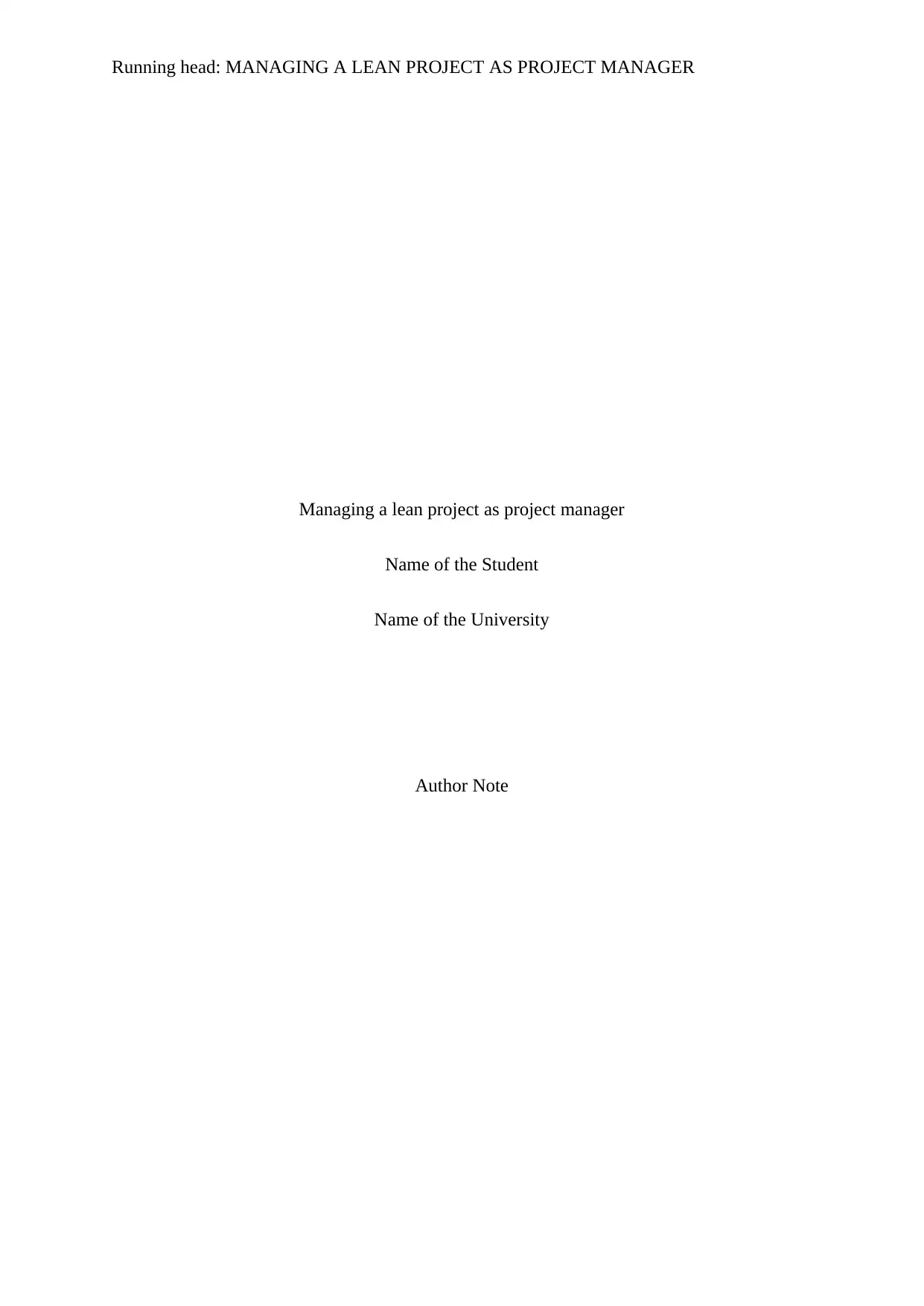
Running head: MANAGING A LEAN PROJECT AS PROJECT MANAGER
Managing a lean project as project manager
Name of the Student
Name of the University
Author Note
Managing a lean project as project manager
Name of the Student
Name of the University
Author Note
Paraphrase This Document
Need a fresh take? Get an instant paraphrase of this document with our AI Paraphraser
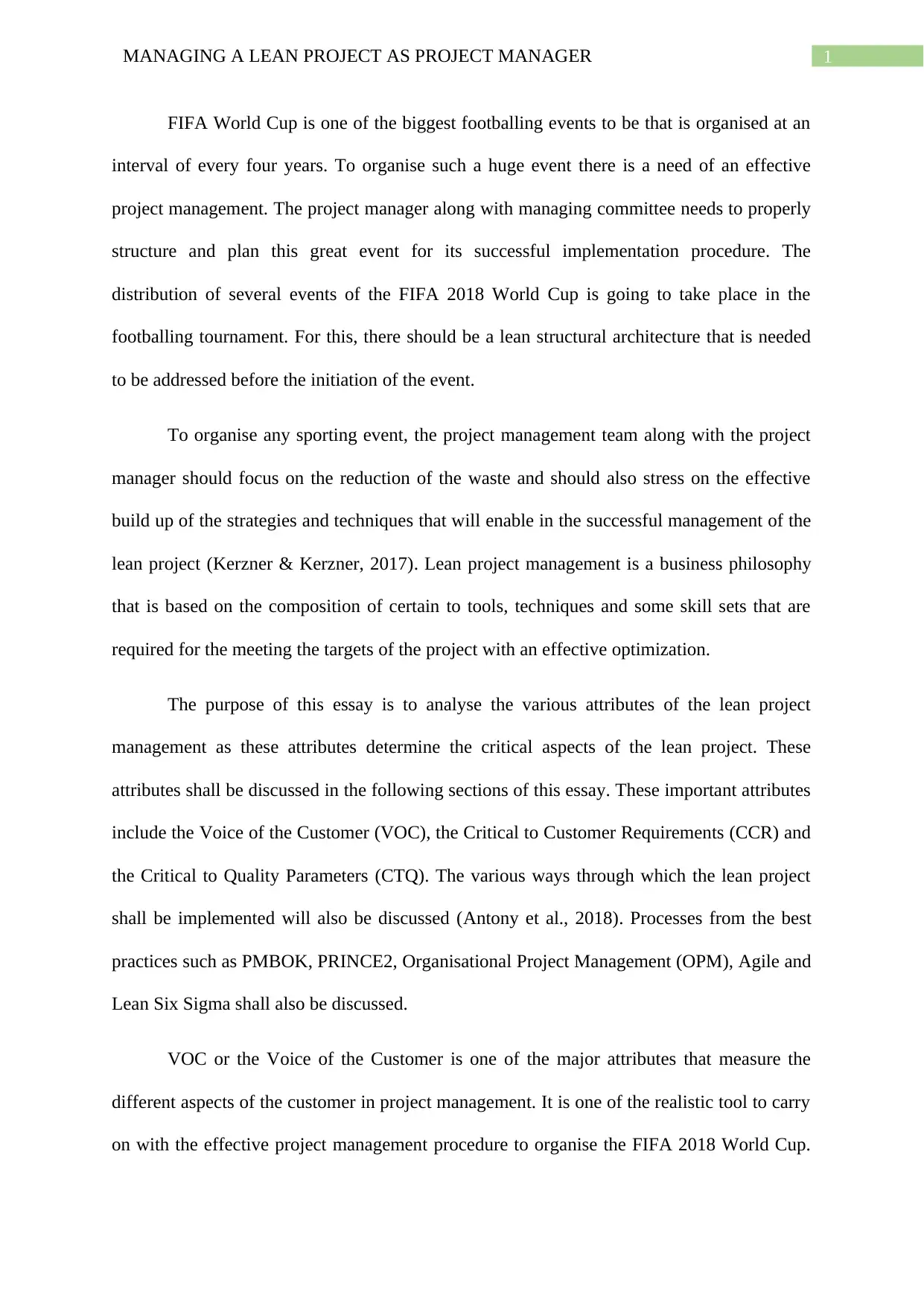
1MANAGING A LEAN PROJECT AS PROJECT MANAGER
FIFA World Cup is one of the biggest footballing events to be that is organised at an
interval of every four years. To organise such a huge event there is a need of an effective
project management. The project manager along with managing committee needs to properly
structure and plan this great event for its successful implementation procedure. The
distribution of several events of the FIFA 2018 World Cup is going to take place in the
footballing tournament. For this, there should be a lean structural architecture that is needed
to be addressed before the initiation of the event.
To organise any sporting event, the project management team along with the project
manager should focus on the reduction of the waste and should also stress on the effective
build up of the strategies and techniques that will enable in the successful management of the
lean project (Kerzner & Kerzner, 2017). Lean project management is a business philosophy
that is based on the composition of certain to tools, techniques and some skill sets that are
required for the meeting the targets of the project with an effective optimization.
The purpose of this essay is to analyse the various attributes of the lean project
management as these attributes determine the critical aspects of the lean project. These
attributes shall be discussed in the following sections of this essay. These important attributes
include the Voice of the Customer (VOC), the Critical to Customer Requirements (CCR) and
the Critical to Quality Parameters (CTQ). The various ways through which the lean project
shall be implemented will also be discussed (Antony et al., 2018). Processes from the best
practices such as PMBOK, PRINCE2, Organisational Project Management (OPM), Agile and
Lean Six Sigma shall also be discussed.
VOC or the Voice of the Customer is one of the major attributes that measure the
different aspects of the customer in project management. It is one of the realistic tool to carry
on with the effective project management procedure to organise the FIFA 2018 World Cup.
FIFA World Cup is one of the biggest footballing events to be that is organised at an
interval of every four years. To organise such a huge event there is a need of an effective
project management. The project manager along with managing committee needs to properly
structure and plan this great event for its successful implementation procedure. The
distribution of several events of the FIFA 2018 World Cup is going to take place in the
footballing tournament. For this, there should be a lean structural architecture that is needed
to be addressed before the initiation of the event.
To organise any sporting event, the project management team along with the project
manager should focus on the reduction of the waste and should also stress on the effective
build up of the strategies and techniques that will enable in the successful management of the
lean project (Kerzner & Kerzner, 2017). Lean project management is a business philosophy
that is based on the composition of certain to tools, techniques and some skill sets that are
required for the meeting the targets of the project with an effective optimization.
The purpose of this essay is to analyse the various attributes of the lean project
management as these attributes determine the critical aspects of the lean project. These
attributes shall be discussed in the following sections of this essay. These important attributes
include the Voice of the Customer (VOC), the Critical to Customer Requirements (CCR) and
the Critical to Quality Parameters (CTQ). The various ways through which the lean project
shall be implemented will also be discussed (Antony et al., 2018). Processes from the best
practices such as PMBOK, PRINCE2, Organisational Project Management (OPM), Agile and
Lean Six Sigma shall also be discussed.
VOC or the Voice of the Customer is one of the major attributes that measure the
different aspects of the customer in project management. It is one of the realistic tool to carry
on with the effective project management procedure to organise the FIFA 2018 World Cup.
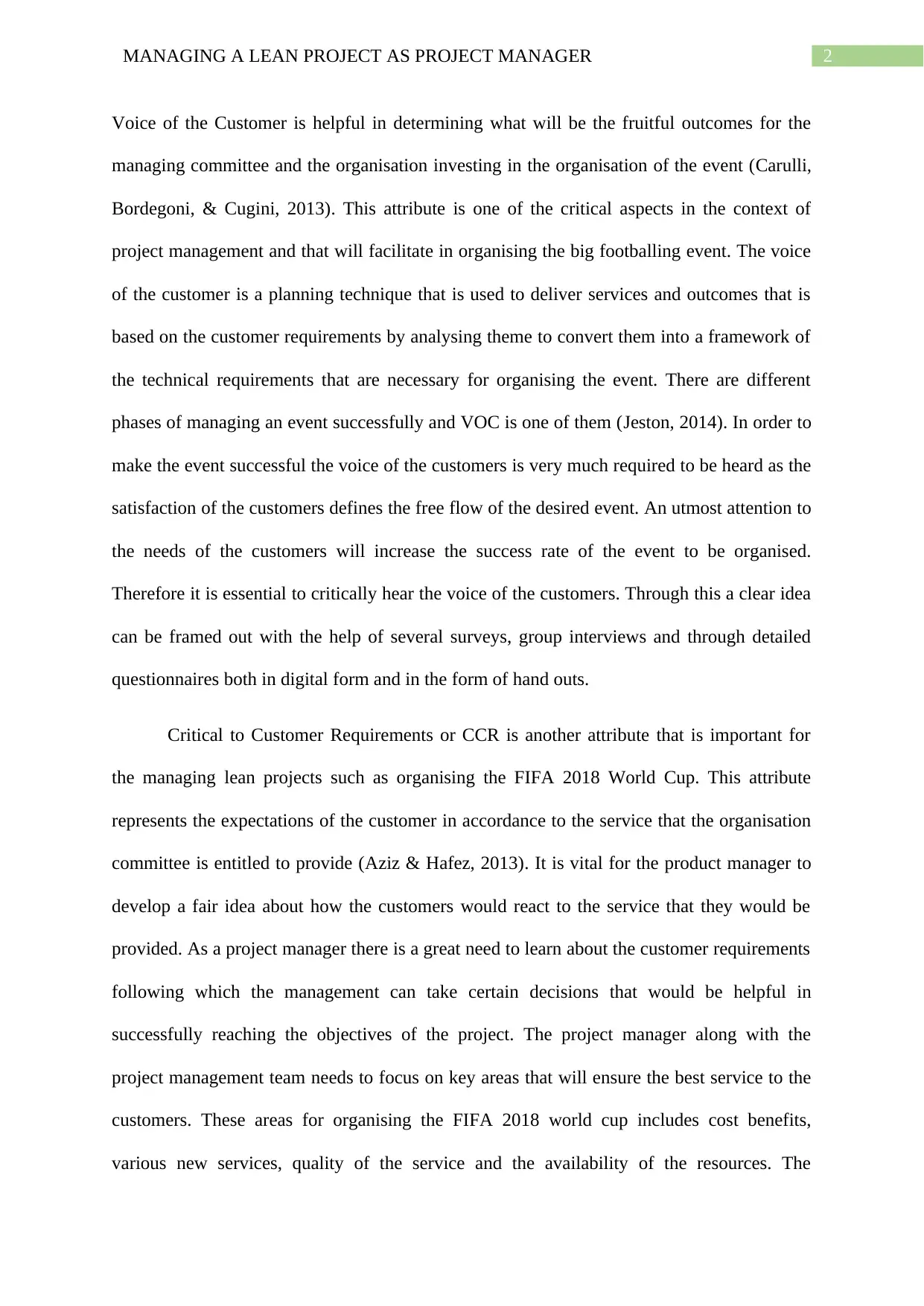
2MANAGING A LEAN PROJECT AS PROJECT MANAGER
Voice of the Customer is helpful in determining what will be the fruitful outcomes for the
managing committee and the organisation investing in the organisation of the event (Carulli,
Bordegoni, & Cugini, 2013). This attribute is one of the critical aspects in the context of
project management and that will facilitate in organising the big footballing event. The voice
of the customer is a planning technique that is used to deliver services and outcomes that is
based on the customer requirements by analysing theme to convert them into a framework of
the technical requirements that are necessary for organising the event. There are different
phases of managing an event successfully and VOC is one of them (Jeston, 2014). In order to
make the event successful the voice of the customers is very much required to be heard as the
satisfaction of the customers defines the free flow of the desired event. An utmost attention to
the needs of the customers will increase the success rate of the event to be organised.
Therefore it is essential to critically hear the voice of the customers. Through this a clear idea
can be framed out with the help of several surveys, group interviews and through detailed
questionnaires both in digital form and in the form of hand outs.
Critical to Customer Requirements or CCR is another attribute that is important for
the managing lean projects such as organising the FIFA 2018 World Cup. This attribute
represents the expectations of the customer in accordance to the service that the organisation
committee is entitled to provide (Aziz & Hafez, 2013). It is vital for the product manager to
develop a fair idea about how the customers would react to the service that they would be
provided. As a project manager there is a great need to learn about the customer requirements
following which the management can take certain decisions that would be helpful in
successfully reaching the objectives of the project. The project manager along with the
project management team needs to focus on key areas that will ensure the best service to the
customers. These areas for organising the FIFA 2018 world cup includes cost benefits,
various new services, quality of the service and the availability of the resources. The
Voice of the Customer is helpful in determining what will be the fruitful outcomes for the
managing committee and the organisation investing in the organisation of the event (Carulli,
Bordegoni, & Cugini, 2013). This attribute is one of the critical aspects in the context of
project management and that will facilitate in organising the big footballing event. The voice
of the customer is a planning technique that is used to deliver services and outcomes that is
based on the customer requirements by analysing theme to convert them into a framework of
the technical requirements that are necessary for organising the event. There are different
phases of managing an event successfully and VOC is one of them (Jeston, 2014). In order to
make the event successful the voice of the customers is very much required to be heard as the
satisfaction of the customers defines the free flow of the desired event. An utmost attention to
the needs of the customers will increase the success rate of the event to be organised.
Therefore it is essential to critically hear the voice of the customers. Through this a clear idea
can be framed out with the help of several surveys, group interviews and through detailed
questionnaires both in digital form and in the form of hand outs.
Critical to Customer Requirements or CCR is another attribute that is important for
the managing lean projects such as organising the FIFA 2018 World Cup. This attribute
represents the expectations of the customer in accordance to the service that the organisation
committee is entitled to provide (Aziz & Hafez, 2013). It is vital for the product manager to
develop a fair idea about how the customers would react to the service that they would be
provided. As a project manager there is a great need to learn about the customer requirements
following which the management can take certain decisions that would be helpful in
successfully reaching the objectives of the project. The project manager along with the
project management team needs to focus on key areas that will ensure the best service to the
customers. These areas for organising the FIFA 2018 world cup includes cost benefits,
various new services, quality of the service and the availability of the resources. The
⊘ This is a preview!⊘
Do you want full access?
Subscribe today to unlock all pages.

Trusted by 1+ million students worldwide
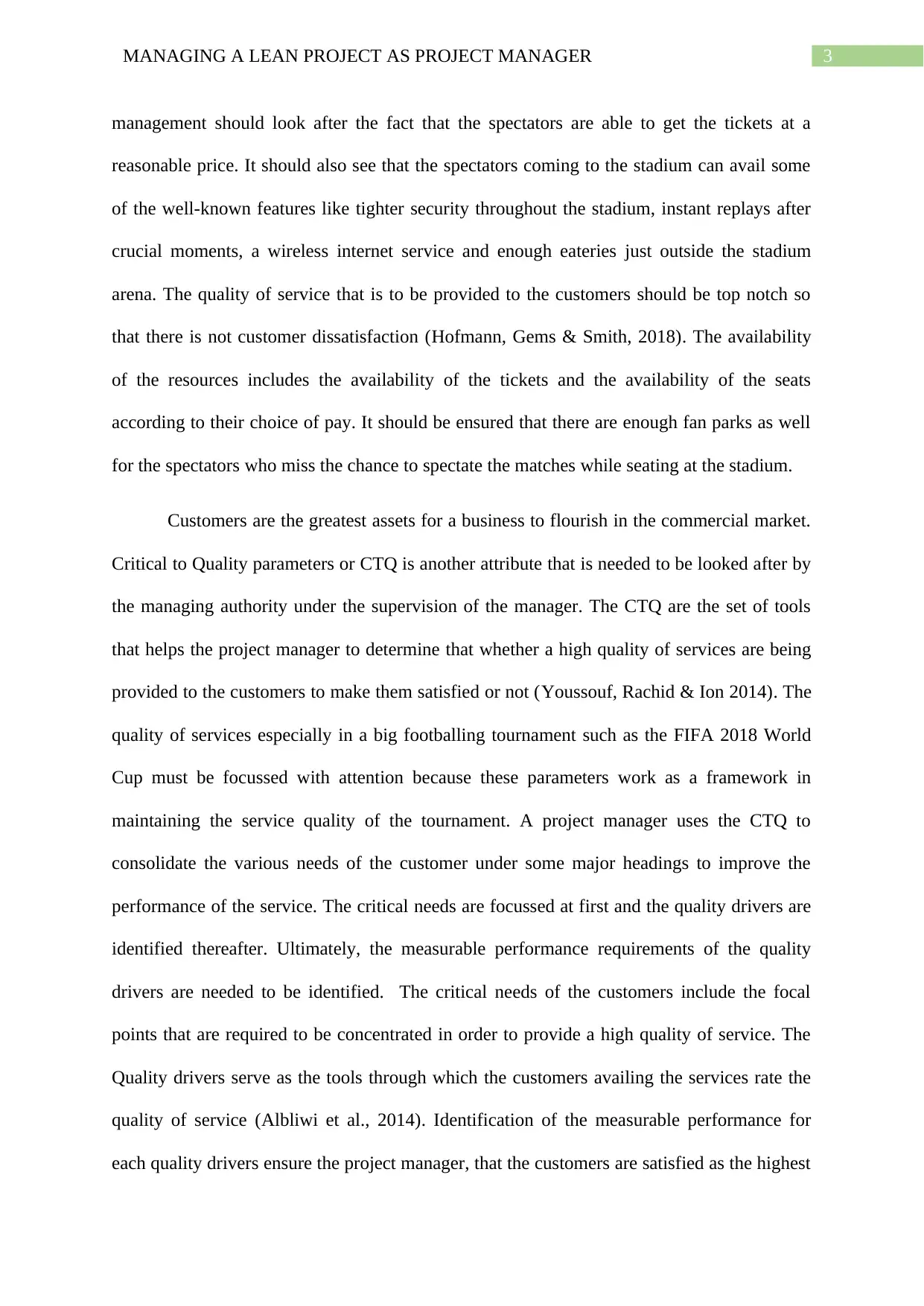
3MANAGING A LEAN PROJECT AS PROJECT MANAGER
management should look after the fact that the spectators are able to get the tickets at a
reasonable price. It should also see that the spectators coming to the stadium can avail some
of the well-known features like tighter security throughout the stadium, instant replays after
crucial moments, a wireless internet service and enough eateries just outside the stadium
arena. The quality of service that is to be provided to the customers should be top notch so
that there is not customer dissatisfaction (Hofmann, Gems & Smith, 2018). The availability
of the resources includes the availability of the tickets and the availability of the seats
according to their choice of pay. It should be ensured that there are enough fan parks as well
for the spectators who miss the chance to spectate the matches while seating at the stadium.
Customers are the greatest assets for a business to flourish in the commercial market.
Critical to Quality parameters or CTQ is another attribute that is needed to be looked after by
the managing authority under the supervision of the manager. The CTQ are the set of tools
that helps the project manager to determine that whether a high quality of services are being
provided to the customers to make them satisfied or not (Youssouf, Rachid & Ion 2014). The
quality of services especially in a big footballing tournament such as the FIFA 2018 World
Cup must be focussed with attention because these parameters work as a framework in
maintaining the service quality of the tournament. A project manager uses the CTQ to
consolidate the various needs of the customer under some major headings to improve the
performance of the service. The critical needs are focussed at first and the quality drivers are
identified thereafter. Ultimately, the measurable performance requirements of the quality
drivers are needed to be identified. The critical needs of the customers include the focal
points that are required to be concentrated in order to provide a high quality of service. The
Quality drivers serve as the tools through which the customers availing the services rate the
quality of service (Albliwi et al., 2014). Identification of the measurable performance for
each quality drivers ensure the project manager, that the customers are satisfied as the highest
management should look after the fact that the spectators are able to get the tickets at a
reasonable price. It should also see that the spectators coming to the stadium can avail some
of the well-known features like tighter security throughout the stadium, instant replays after
crucial moments, a wireless internet service and enough eateries just outside the stadium
arena. The quality of service that is to be provided to the customers should be top notch so
that there is not customer dissatisfaction (Hofmann, Gems & Smith, 2018). The availability
of the resources includes the availability of the tickets and the availability of the seats
according to their choice of pay. It should be ensured that there are enough fan parks as well
for the spectators who miss the chance to spectate the matches while seating at the stadium.
Customers are the greatest assets for a business to flourish in the commercial market.
Critical to Quality parameters or CTQ is another attribute that is needed to be looked after by
the managing authority under the supervision of the manager. The CTQ are the set of tools
that helps the project manager to determine that whether a high quality of services are being
provided to the customers to make them satisfied or not (Youssouf, Rachid & Ion 2014). The
quality of services especially in a big footballing tournament such as the FIFA 2018 World
Cup must be focussed with attention because these parameters work as a framework in
maintaining the service quality of the tournament. A project manager uses the CTQ to
consolidate the various needs of the customer under some major headings to improve the
performance of the service. The critical needs are focussed at first and the quality drivers are
identified thereafter. Ultimately, the measurable performance requirements of the quality
drivers are needed to be identified. The critical needs of the customers include the focal
points that are required to be concentrated in order to provide a high quality of service. The
Quality drivers serve as the tools through which the customers availing the services rate the
quality of service (Albliwi et al., 2014). Identification of the measurable performance for
each quality drivers ensure the project manager, that the customers are satisfied as the highest
Paraphrase This Document
Need a fresh take? Get an instant paraphrase of this document with our AI Paraphraser
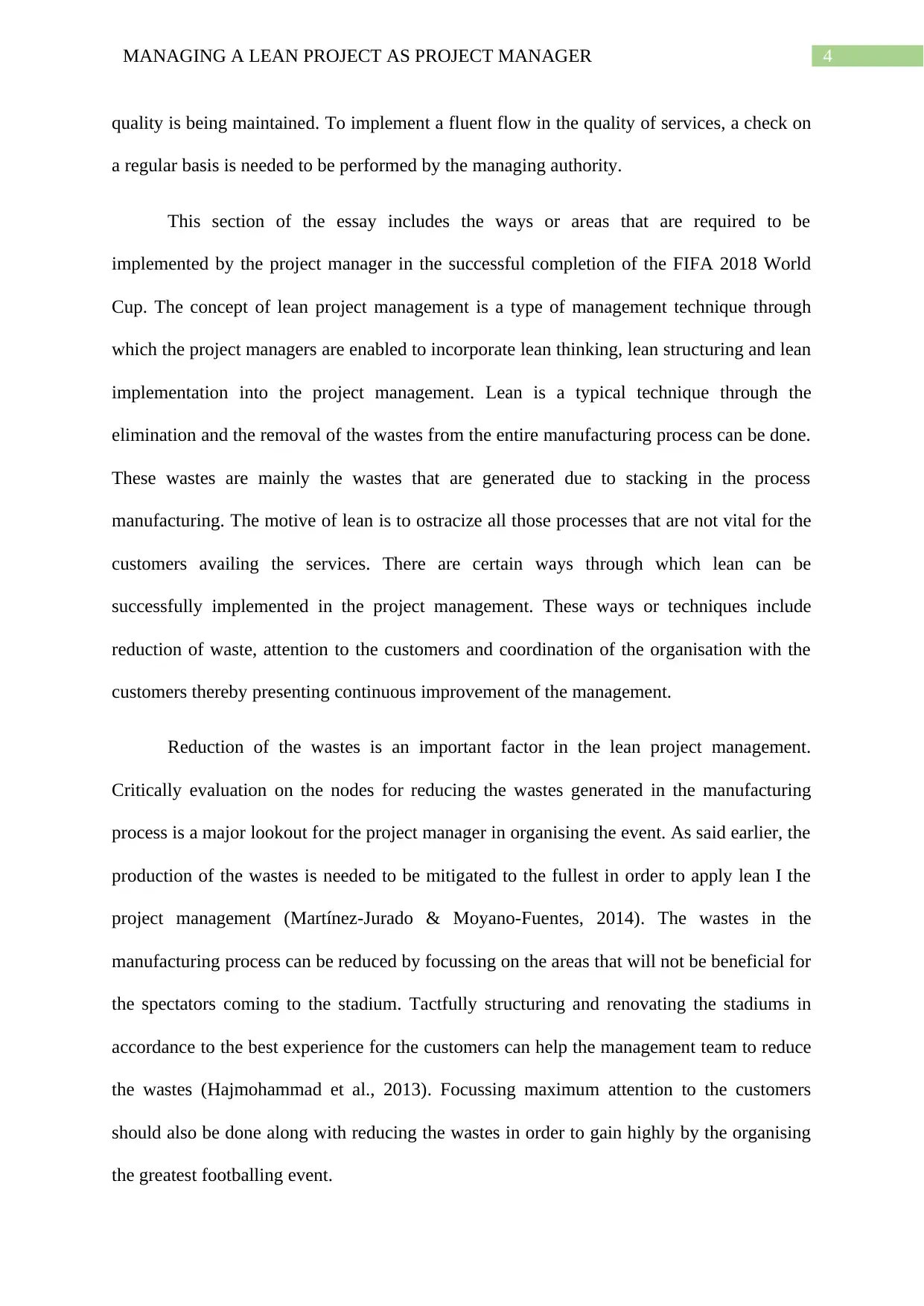
4MANAGING A LEAN PROJECT AS PROJECT MANAGER
quality is being maintained. To implement a fluent flow in the quality of services, a check on
a regular basis is needed to be performed by the managing authority.
This section of the essay includes the ways or areas that are required to be
implemented by the project manager in the successful completion of the FIFA 2018 World
Cup. The concept of lean project management is a type of management technique through
which the project managers are enabled to incorporate lean thinking, lean structuring and lean
implementation into the project management. Lean is a typical technique through the
elimination and the removal of the wastes from the entire manufacturing process can be done.
These wastes are mainly the wastes that are generated due to stacking in the process
manufacturing. The motive of lean is to ostracize all those processes that are not vital for the
customers availing the services. There are certain ways through which lean can be
successfully implemented in the project management. These ways or techniques include
reduction of waste, attention to the customers and coordination of the organisation with the
customers thereby presenting continuous improvement of the management.
Reduction of the wastes is an important factor in the lean project management.
Critically evaluation on the nodes for reducing the wastes generated in the manufacturing
process is a major lookout for the project manager in organising the event. As said earlier, the
production of the wastes is needed to be mitigated to the fullest in order to apply lean I the
project management (Martínez-Jurado & Moyano-Fuentes, 2014). The wastes in the
manufacturing process can be reduced by focussing on the areas that will not be beneficial for
the spectators coming to the stadium. Tactfully structuring and renovating the stadiums in
accordance to the best experience for the customers can help the management team to reduce
the wastes (Hajmohammad et al., 2013). Focussing maximum attention to the customers
should also be done along with reducing the wastes in order to gain highly by the organising
the greatest footballing event.
quality is being maintained. To implement a fluent flow in the quality of services, a check on
a regular basis is needed to be performed by the managing authority.
This section of the essay includes the ways or areas that are required to be
implemented by the project manager in the successful completion of the FIFA 2018 World
Cup. The concept of lean project management is a type of management technique through
which the project managers are enabled to incorporate lean thinking, lean structuring and lean
implementation into the project management. Lean is a typical technique through the
elimination and the removal of the wastes from the entire manufacturing process can be done.
These wastes are mainly the wastes that are generated due to stacking in the process
manufacturing. The motive of lean is to ostracize all those processes that are not vital for the
customers availing the services. There are certain ways through which lean can be
successfully implemented in the project management. These ways or techniques include
reduction of waste, attention to the customers and coordination of the organisation with the
customers thereby presenting continuous improvement of the management.
Reduction of the wastes is an important factor in the lean project management.
Critically evaluation on the nodes for reducing the wastes generated in the manufacturing
process is a major lookout for the project manager in organising the event. As said earlier, the
production of the wastes is needed to be mitigated to the fullest in order to apply lean I the
project management (Martínez-Jurado & Moyano-Fuentes, 2014). The wastes in the
manufacturing process can be reduced by focussing on the areas that will not be beneficial for
the spectators coming to the stadium. Tactfully structuring and renovating the stadiums in
accordance to the best experience for the customers can help the management team to reduce
the wastes (Hajmohammad et al., 2013). Focussing maximum attention to the customers
should also be done along with reducing the wastes in order to gain highly by the organising
the greatest footballing event.
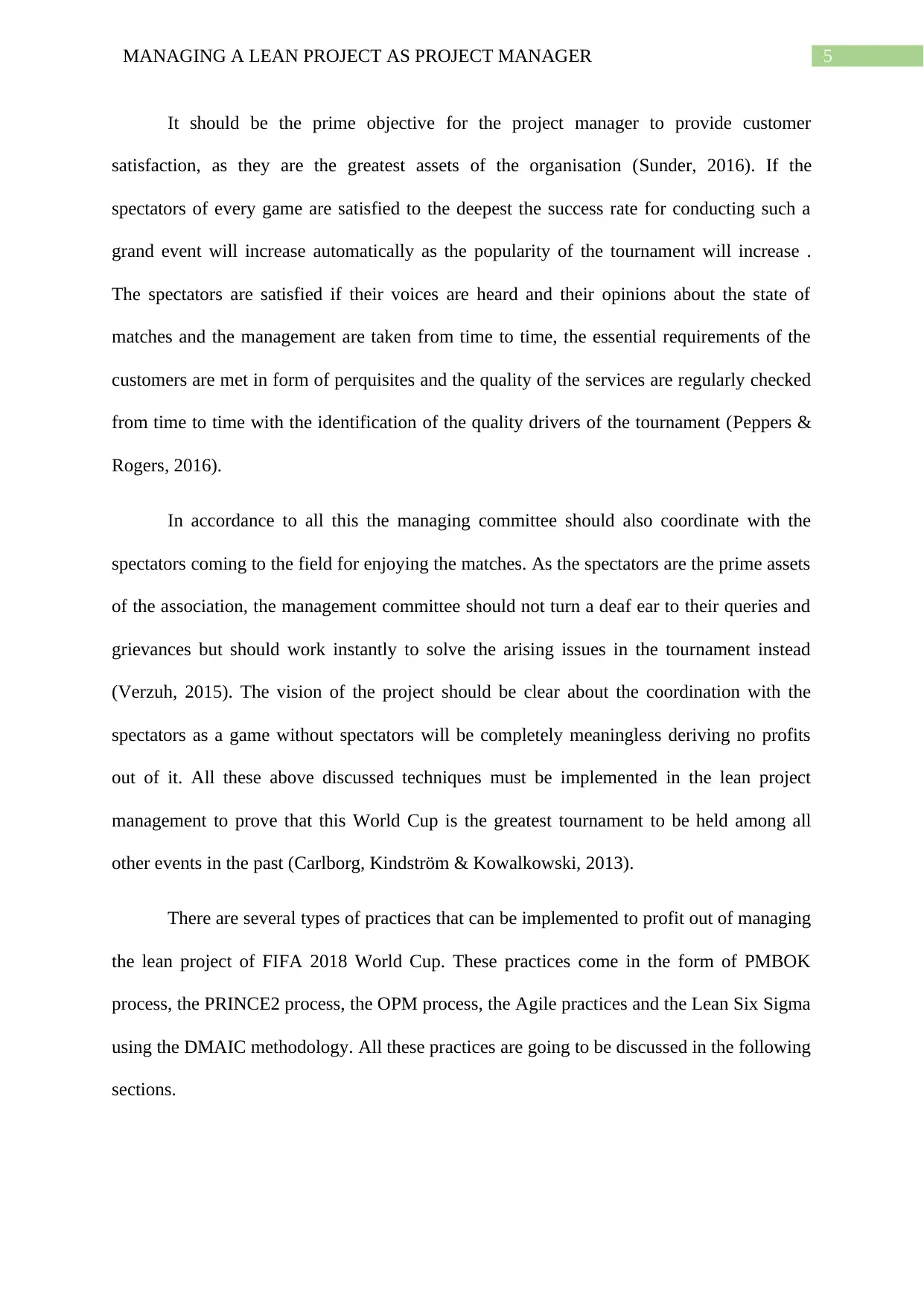
5MANAGING A LEAN PROJECT AS PROJECT MANAGER
It should be the prime objective for the project manager to provide customer
satisfaction, as they are the greatest assets of the organisation (Sunder, 2016). If the
spectators of every game are satisfied to the deepest the success rate for conducting such a
grand event will increase automatically as the popularity of the tournament will increase .
The spectators are satisfied if their voices are heard and their opinions about the state of
matches and the management are taken from time to time, the essential requirements of the
customers are met in form of perquisites and the quality of the services are regularly checked
from time to time with the identification of the quality drivers of the tournament (Peppers &
Rogers, 2016).
In accordance to all this the managing committee should also coordinate with the
spectators coming to the field for enjoying the matches. As the spectators are the prime assets
of the association, the management committee should not turn a deaf ear to their queries and
grievances but should work instantly to solve the arising issues in the tournament instead
(Verzuh, 2015). The vision of the project should be clear about the coordination with the
spectators as a game without spectators will be completely meaningless deriving no profits
out of it. All these above discussed techniques must be implemented in the lean project
management to prove that this World Cup is the greatest tournament to be held among all
other events in the past (Carlborg, Kindström & Kowalkowski, 2013).
There are several types of practices that can be implemented to profit out of managing
the lean project of FIFA 2018 World Cup. These practices come in the form of PMBOK
process, the PRINCE2 process, the OPM process, the Agile practices and the Lean Six Sigma
using the DMAIC methodology. All these practices are going to be discussed in the following
sections.
It should be the prime objective for the project manager to provide customer
satisfaction, as they are the greatest assets of the organisation (Sunder, 2016). If the
spectators of every game are satisfied to the deepest the success rate for conducting such a
grand event will increase automatically as the popularity of the tournament will increase .
The spectators are satisfied if their voices are heard and their opinions about the state of
matches and the management are taken from time to time, the essential requirements of the
customers are met in form of perquisites and the quality of the services are regularly checked
from time to time with the identification of the quality drivers of the tournament (Peppers &
Rogers, 2016).
In accordance to all this the managing committee should also coordinate with the
spectators coming to the field for enjoying the matches. As the spectators are the prime assets
of the association, the management committee should not turn a deaf ear to their queries and
grievances but should work instantly to solve the arising issues in the tournament instead
(Verzuh, 2015). The vision of the project should be clear about the coordination with the
spectators as a game without spectators will be completely meaningless deriving no profits
out of it. All these above discussed techniques must be implemented in the lean project
management to prove that this World Cup is the greatest tournament to be held among all
other events in the past (Carlborg, Kindström & Kowalkowski, 2013).
There are several types of practices that can be implemented to profit out of managing
the lean project of FIFA 2018 World Cup. These practices come in the form of PMBOK
process, the PRINCE2 process, the OPM process, the Agile practices and the Lean Six Sigma
using the DMAIC methodology. All these practices are going to be discussed in the following
sections.
⊘ This is a preview!⊘
Do you want full access?
Subscribe today to unlock all pages.

Trusted by 1+ million students worldwide
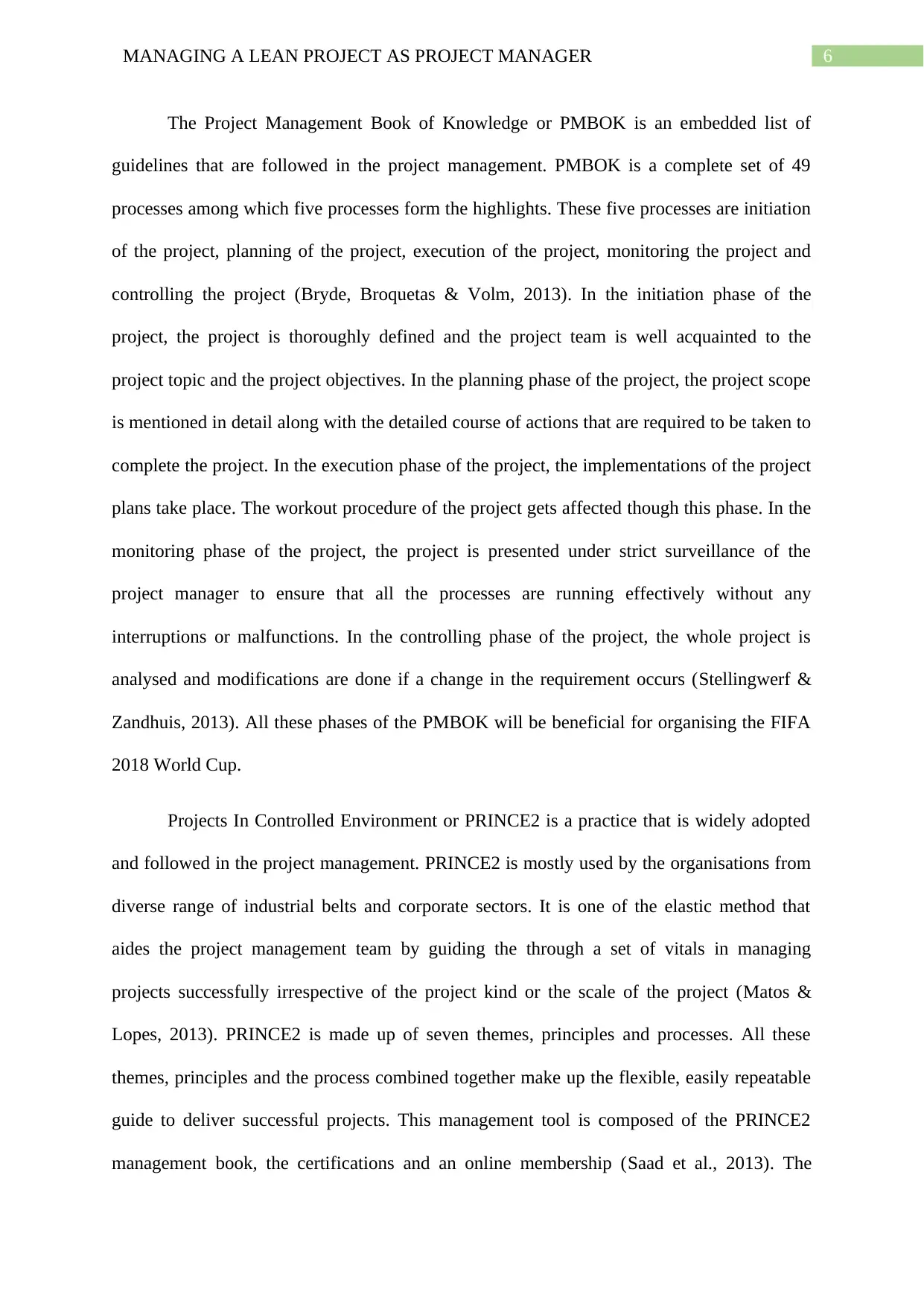
6MANAGING A LEAN PROJECT AS PROJECT MANAGER
The Project Management Book of Knowledge or PMBOK is an embedded list of
guidelines that are followed in the project management. PMBOK is a complete set of 49
processes among which five processes form the highlights. These five processes are initiation
of the project, planning of the project, execution of the project, monitoring the project and
controlling the project (Bryde, Broquetas & Volm, 2013). In the initiation phase of the
project, the project is thoroughly defined and the project team is well acquainted to the
project topic and the project objectives. In the planning phase of the project, the project scope
is mentioned in detail along with the detailed course of actions that are required to be taken to
complete the project. In the execution phase of the project, the implementations of the project
plans take place. The workout procedure of the project gets affected though this phase. In the
monitoring phase of the project, the project is presented under strict surveillance of the
project manager to ensure that all the processes are running effectively without any
interruptions or malfunctions. In the controlling phase of the project, the whole project is
analysed and modifications are done if a change in the requirement occurs (Stellingwerf &
Zandhuis, 2013). All these phases of the PMBOK will be beneficial for organising the FIFA
2018 World Cup.
Projects In Controlled Environment or PRINCE2 is a practice that is widely adopted
and followed in the project management. PRINCE2 is mostly used by the organisations from
diverse range of industrial belts and corporate sectors. It is one of the elastic method that
aides the project management team by guiding the through a set of vitals in managing
projects successfully irrespective of the project kind or the scale of the project (Matos &
Lopes, 2013). PRINCE2 is made up of seven themes, principles and processes. All these
themes, principles and the process combined together make up the flexible, easily repeatable
guide to deliver successful projects. This management tool is composed of the PRINCE2
management book, the certifications and an online membership (Saad et al., 2013). The
The Project Management Book of Knowledge or PMBOK is an embedded list of
guidelines that are followed in the project management. PMBOK is a complete set of 49
processes among which five processes form the highlights. These five processes are initiation
of the project, planning of the project, execution of the project, monitoring the project and
controlling the project (Bryde, Broquetas & Volm, 2013). In the initiation phase of the
project, the project is thoroughly defined and the project team is well acquainted to the
project topic and the project objectives. In the planning phase of the project, the project scope
is mentioned in detail along with the detailed course of actions that are required to be taken to
complete the project. In the execution phase of the project, the implementations of the project
plans take place. The workout procedure of the project gets affected though this phase. In the
monitoring phase of the project, the project is presented under strict surveillance of the
project manager to ensure that all the processes are running effectively without any
interruptions or malfunctions. In the controlling phase of the project, the whole project is
analysed and modifications are done if a change in the requirement occurs (Stellingwerf &
Zandhuis, 2013). All these phases of the PMBOK will be beneficial for organising the FIFA
2018 World Cup.
Projects In Controlled Environment or PRINCE2 is a practice that is widely adopted
and followed in the project management. PRINCE2 is mostly used by the organisations from
diverse range of industrial belts and corporate sectors. It is one of the elastic method that
aides the project management team by guiding the through a set of vitals in managing
projects successfully irrespective of the project kind or the scale of the project (Matos &
Lopes, 2013). PRINCE2 is made up of seven themes, principles and processes. All these
themes, principles and the process combined together make up the flexible, easily repeatable
guide to deliver successful projects. This management tool is composed of the PRINCE2
management book, the certifications and an online membership (Saad et al., 2013). The
Paraphrase This Document
Need a fresh take? Get an instant paraphrase of this document with our AI Paraphraser
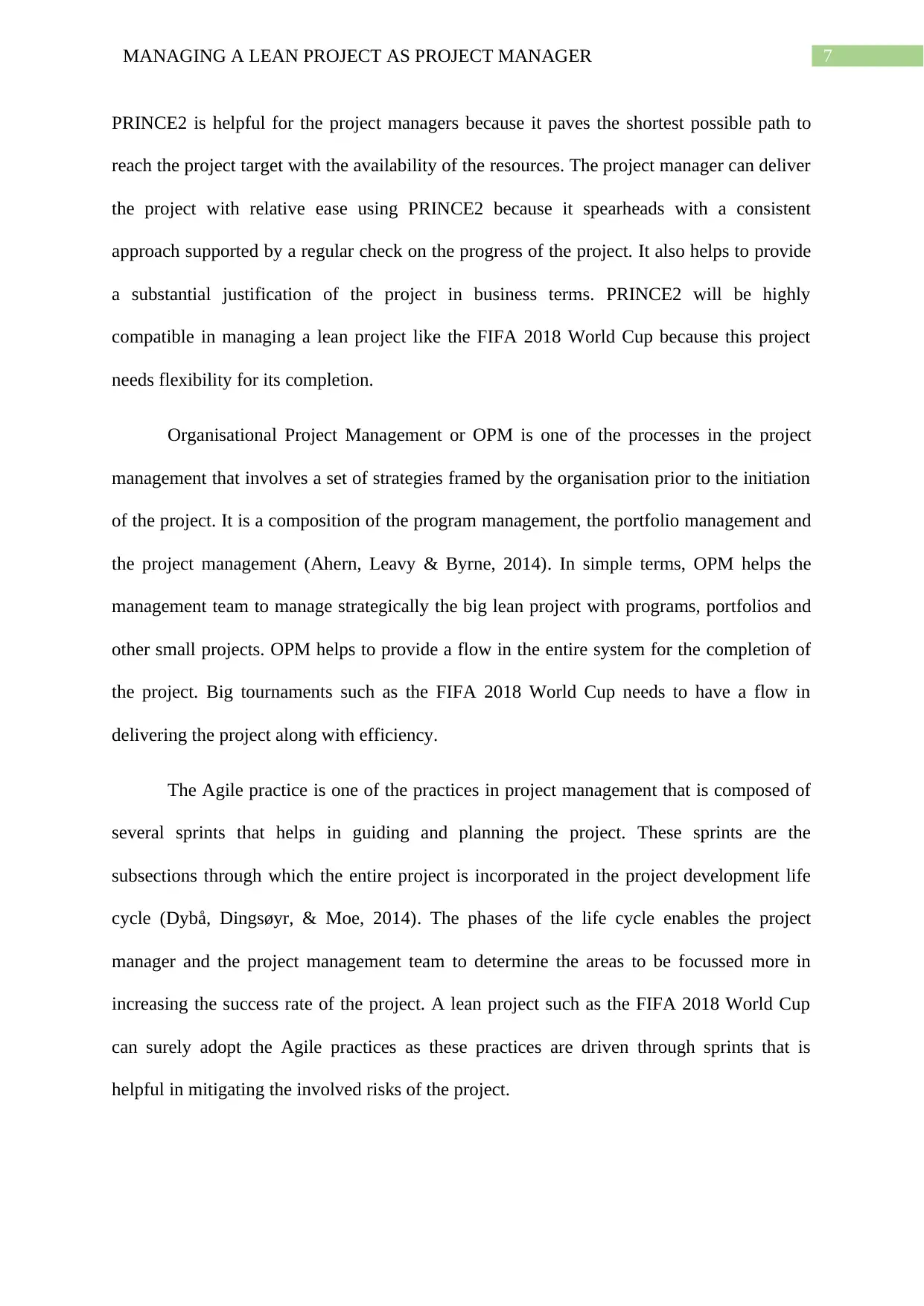
7MANAGING A LEAN PROJECT AS PROJECT MANAGER
PRINCE2 is helpful for the project managers because it paves the shortest possible path to
reach the project target with the availability of the resources. The project manager can deliver
the project with relative ease using PRINCE2 because it spearheads with a consistent
approach supported by a regular check on the progress of the project. It also helps to provide
a substantial justification of the project in business terms. PRINCE2 will be highly
compatible in managing a lean project like the FIFA 2018 World Cup because this project
needs flexibility for its completion.
Organisational Project Management or OPM is one of the processes in the project
management that involves a set of strategies framed by the organisation prior to the initiation
of the project. It is a composition of the program management, the portfolio management and
the project management (Ahern, Leavy & Byrne, 2014). In simple terms, OPM helps the
management team to manage strategically the big lean project with programs, portfolios and
other small projects. OPM helps to provide a flow in the entire system for the completion of
the project. Big tournaments such as the FIFA 2018 World Cup needs to have a flow in
delivering the project along with efficiency.
The Agile practice is one of the practices in project management that is composed of
several sprints that helps in guiding and planning the project. These sprints are the
subsections through which the entire project is incorporated in the project development life
cycle (Dybå, Dingsøyr, & Moe, 2014). The phases of the life cycle enables the project
manager and the project management team to determine the areas to be focussed more in
increasing the success rate of the project. A lean project such as the FIFA 2018 World Cup
can surely adopt the Agile practices as these practices are driven through sprints that is
helpful in mitigating the involved risks of the project.
PRINCE2 is helpful for the project managers because it paves the shortest possible path to
reach the project target with the availability of the resources. The project manager can deliver
the project with relative ease using PRINCE2 because it spearheads with a consistent
approach supported by a regular check on the progress of the project. It also helps to provide
a substantial justification of the project in business terms. PRINCE2 will be highly
compatible in managing a lean project like the FIFA 2018 World Cup because this project
needs flexibility for its completion.
Organisational Project Management or OPM is one of the processes in the project
management that involves a set of strategies framed by the organisation prior to the initiation
of the project. It is a composition of the program management, the portfolio management and
the project management (Ahern, Leavy & Byrne, 2014). In simple terms, OPM helps the
management team to manage strategically the big lean project with programs, portfolios and
other small projects. OPM helps to provide a flow in the entire system for the completion of
the project. Big tournaments such as the FIFA 2018 World Cup needs to have a flow in
delivering the project along with efficiency.
The Agile practice is one of the practices in project management that is composed of
several sprints that helps in guiding and planning the project. These sprints are the
subsections through which the entire project is incorporated in the project development life
cycle (Dybå, Dingsøyr, & Moe, 2014). The phases of the life cycle enables the project
manager and the project management team to determine the areas to be focussed more in
increasing the success rate of the project. A lean project such as the FIFA 2018 World Cup
can surely adopt the Agile practices as these practices are driven through sprints that is
helpful in mitigating the involved risks of the project.
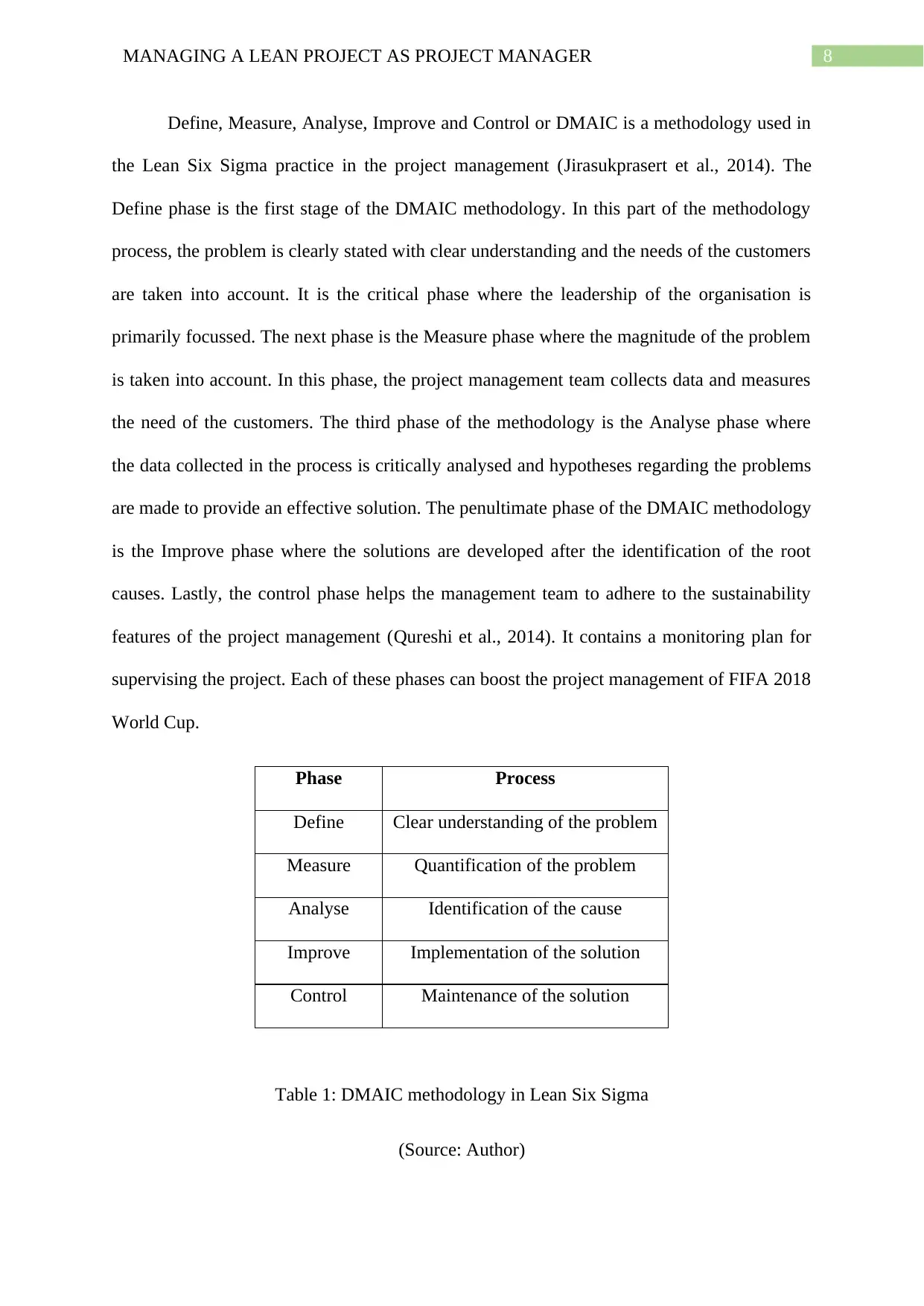
8MANAGING A LEAN PROJECT AS PROJECT MANAGER
Define, Measure, Analyse, Improve and Control or DMAIC is a methodology used in
the Lean Six Sigma practice in the project management (Jirasukprasert et al., 2014). The
Define phase is the first stage of the DMAIC methodology. In this part of the methodology
process, the problem is clearly stated with clear understanding and the needs of the customers
are taken into account. It is the critical phase where the leadership of the organisation is
primarily focussed. The next phase is the Measure phase where the magnitude of the problem
is taken into account. In this phase, the project management team collects data and measures
the need of the customers. The third phase of the methodology is the Analyse phase where
the data collected in the process is critically analysed and hypotheses regarding the problems
are made to provide an effective solution. The penultimate phase of the DMAIC methodology
is the Improve phase where the solutions are developed after the identification of the root
causes. Lastly, the control phase helps the management team to adhere to the sustainability
features of the project management (Qureshi et al., 2014). It contains a monitoring plan for
supervising the project. Each of these phases can boost the project management of FIFA 2018
World Cup.
Phase Process
Define Clear understanding of the problem
Measure Quantification of the problem
Analyse Identification of the cause
Improve Implementation of the solution
Control Maintenance of the solution
Table 1: DMAIC methodology in Lean Six Sigma
(Source: Author)
Define, Measure, Analyse, Improve and Control or DMAIC is a methodology used in
the Lean Six Sigma practice in the project management (Jirasukprasert et al., 2014). The
Define phase is the first stage of the DMAIC methodology. In this part of the methodology
process, the problem is clearly stated with clear understanding and the needs of the customers
are taken into account. It is the critical phase where the leadership of the organisation is
primarily focussed. The next phase is the Measure phase where the magnitude of the problem
is taken into account. In this phase, the project management team collects data and measures
the need of the customers. The third phase of the methodology is the Analyse phase where
the data collected in the process is critically analysed and hypotheses regarding the problems
are made to provide an effective solution. The penultimate phase of the DMAIC methodology
is the Improve phase where the solutions are developed after the identification of the root
causes. Lastly, the control phase helps the management team to adhere to the sustainability
features of the project management (Qureshi et al., 2014). It contains a monitoring plan for
supervising the project. Each of these phases can boost the project management of FIFA 2018
World Cup.
Phase Process
Define Clear understanding of the problem
Measure Quantification of the problem
Analyse Identification of the cause
Improve Implementation of the solution
Control Maintenance of the solution
Table 1: DMAIC methodology in Lean Six Sigma
(Source: Author)
⊘ This is a preview!⊘
Do you want full access?
Subscribe today to unlock all pages.

Trusted by 1+ million students worldwide
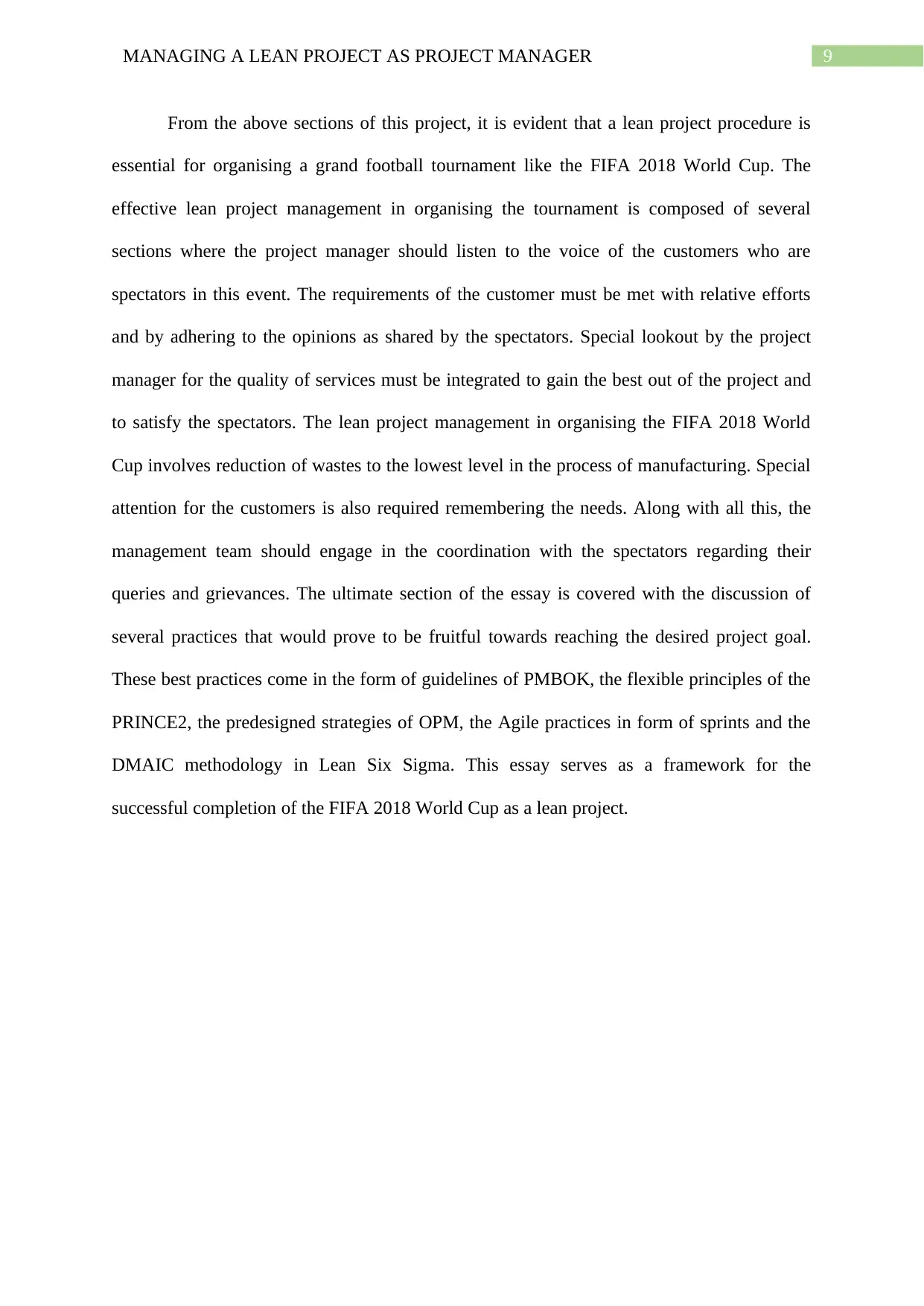
9MANAGING A LEAN PROJECT AS PROJECT MANAGER
From the above sections of this project, it is evident that a lean project procedure is
essential for organising a grand football tournament like the FIFA 2018 World Cup. The
effective lean project management in organising the tournament is composed of several
sections where the project manager should listen to the voice of the customers who are
spectators in this event. The requirements of the customer must be met with relative efforts
and by adhering to the opinions as shared by the spectators. Special lookout by the project
manager for the quality of services must be integrated to gain the best out of the project and
to satisfy the spectators. The lean project management in organising the FIFA 2018 World
Cup involves reduction of wastes to the lowest level in the process of manufacturing. Special
attention for the customers is also required remembering the needs. Along with all this, the
management team should engage in the coordination with the spectators regarding their
queries and grievances. The ultimate section of the essay is covered with the discussion of
several practices that would prove to be fruitful towards reaching the desired project goal.
These best practices come in the form of guidelines of PMBOK, the flexible principles of the
PRINCE2, the predesigned strategies of OPM, the Agile practices in form of sprints and the
DMAIC methodology in Lean Six Sigma. This essay serves as a framework for the
successful completion of the FIFA 2018 World Cup as a lean project.
From the above sections of this project, it is evident that a lean project procedure is
essential for organising a grand football tournament like the FIFA 2018 World Cup. The
effective lean project management in organising the tournament is composed of several
sections where the project manager should listen to the voice of the customers who are
spectators in this event. The requirements of the customer must be met with relative efforts
and by adhering to the opinions as shared by the spectators. Special lookout by the project
manager for the quality of services must be integrated to gain the best out of the project and
to satisfy the spectators. The lean project management in organising the FIFA 2018 World
Cup involves reduction of wastes to the lowest level in the process of manufacturing. Special
attention for the customers is also required remembering the needs. Along with all this, the
management team should engage in the coordination with the spectators regarding their
queries and grievances. The ultimate section of the essay is covered with the discussion of
several practices that would prove to be fruitful towards reaching the desired project goal.
These best practices come in the form of guidelines of PMBOK, the flexible principles of the
PRINCE2, the predesigned strategies of OPM, the Agile practices in form of sprints and the
DMAIC methodology in Lean Six Sigma. This essay serves as a framework for the
successful completion of the FIFA 2018 World Cup as a lean project.
Paraphrase This Document
Need a fresh take? Get an instant paraphrase of this document with our AI Paraphraser
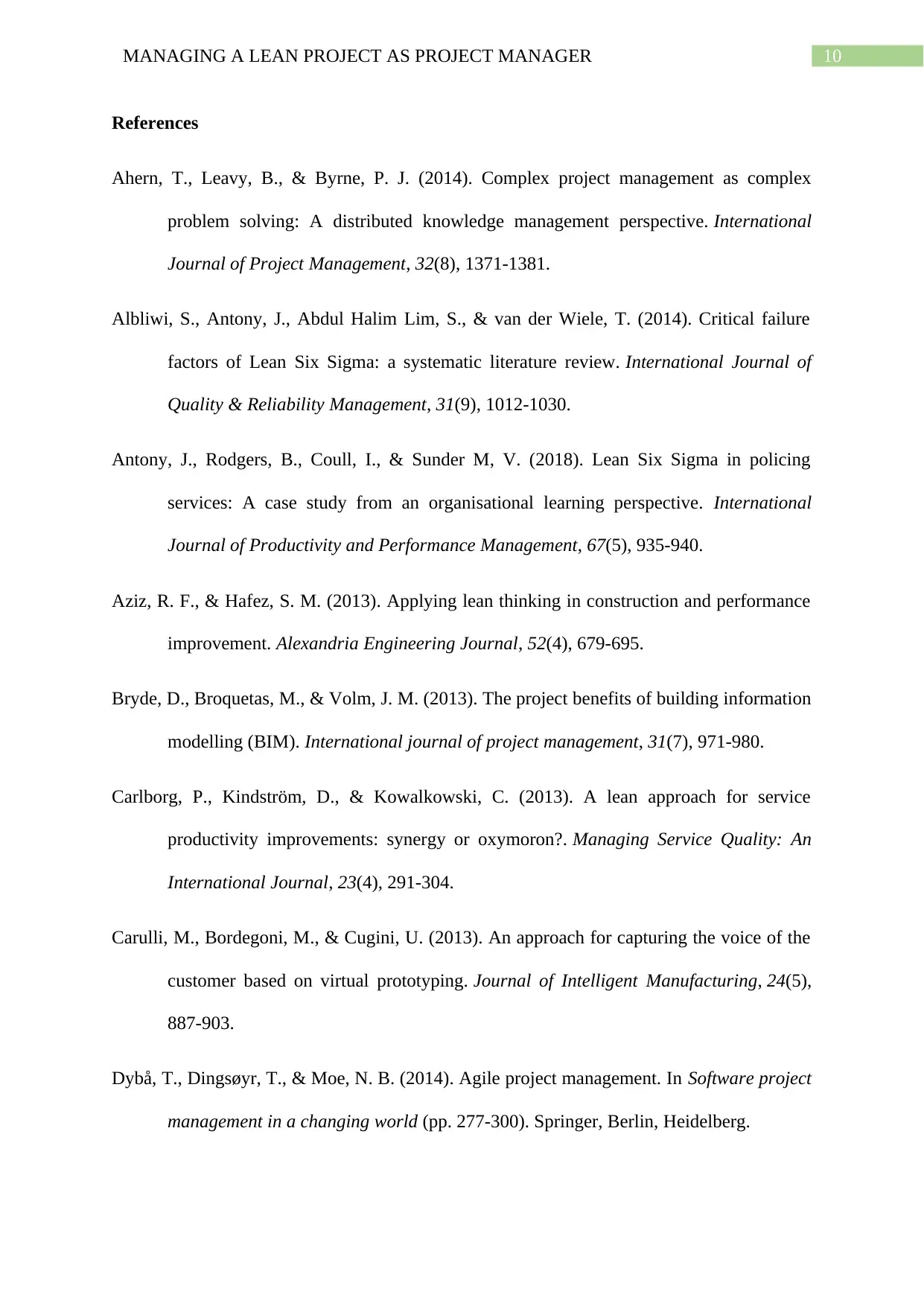
10MANAGING A LEAN PROJECT AS PROJECT MANAGER
References
Ahern, T., Leavy, B., & Byrne, P. J. (2014). Complex project management as complex
problem solving: A distributed knowledge management perspective. International
Journal of Project Management, 32(8), 1371-1381.
Albliwi, S., Antony, J., Abdul Halim Lim, S., & van der Wiele, T. (2014). Critical failure
factors of Lean Six Sigma: a systematic literature review. International Journal of
Quality & Reliability Management, 31(9), 1012-1030.
Antony, J., Rodgers, B., Coull, I., & Sunder M, V. (2018). Lean Six Sigma in policing
services: A case study from an organisational learning perspective. International
Journal of Productivity and Performance Management, 67(5), 935-940.
Aziz, R. F., & Hafez, S. M. (2013). Applying lean thinking in construction and performance
improvement. Alexandria Engineering Journal, 52(4), 679-695.
Bryde, D., Broquetas, M., & Volm, J. M. (2013). The project benefits of building information
modelling (BIM). International journal of project management, 31(7), 971-980.
Carlborg, P., Kindström, D., & Kowalkowski, C. (2013). A lean approach for service
productivity improvements: synergy or oxymoron?. Managing Service Quality: An
International Journal, 23(4), 291-304.
Carulli, M., Bordegoni, M., & Cugini, U. (2013). An approach for capturing the voice of the
customer based on virtual prototyping. Journal of Intelligent Manufacturing, 24(5),
887-903.
Dybå, T., Dingsøyr, T., & Moe, N. B. (2014). Agile project management. In Software project
management in a changing world (pp. 277-300). Springer, Berlin, Heidelberg.
References
Ahern, T., Leavy, B., & Byrne, P. J. (2014). Complex project management as complex
problem solving: A distributed knowledge management perspective. International
Journal of Project Management, 32(8), 1371-1381.
Albliwi, S., Antony, J., Abdul Halim Lim, S., & van der Wiele, T. (2014). Critical failure
factors of Lean Six Sigma: a systematic literature review. International Journal of
Quality & Reliability Management, 31(9), 1012-1030.
Antony, J., Rodgers, B., Coull, I., & Sunder M, V. (2018). Lean Six Sigma in policing
services: A case study from an organisational learning perspective. International
Journal of Productivity and Performance Management, 67(5), 935-940.
Aziz, R. F., & Hafez, S. M. (2013). Applying lean thinking in construction and performance
improvement. Alexandria Engineering Journal, 52(4), 679-695.
Bryde, D., Broquetas, M., & Volm, J. M. (2013). The project benefits of building information
modelling (BIM). International journal of project management, 31(7), 971-980.
Carlborg, P., Kindström, D., & Kowalkowski, C. (2013). A lean approach for service
productivity improvements: synergy or oxymoron?. Managing Service Quality: An
International Journal, 23(4), 291-304.
Carulli, M., Bordegoni, M., & Cugini, U. (2013). An approach for capturing the voice of the
customer based on virtual prototyping. Journal of Intelligent Manufacturing, 24(5),
887-903.
Dybå, T., Dingsøyr, T., & Moe, N. B. (2014). Agile project management. In Software project
management in a changing world (pp. 277-300). Springer, Berlin, Heidelberg.
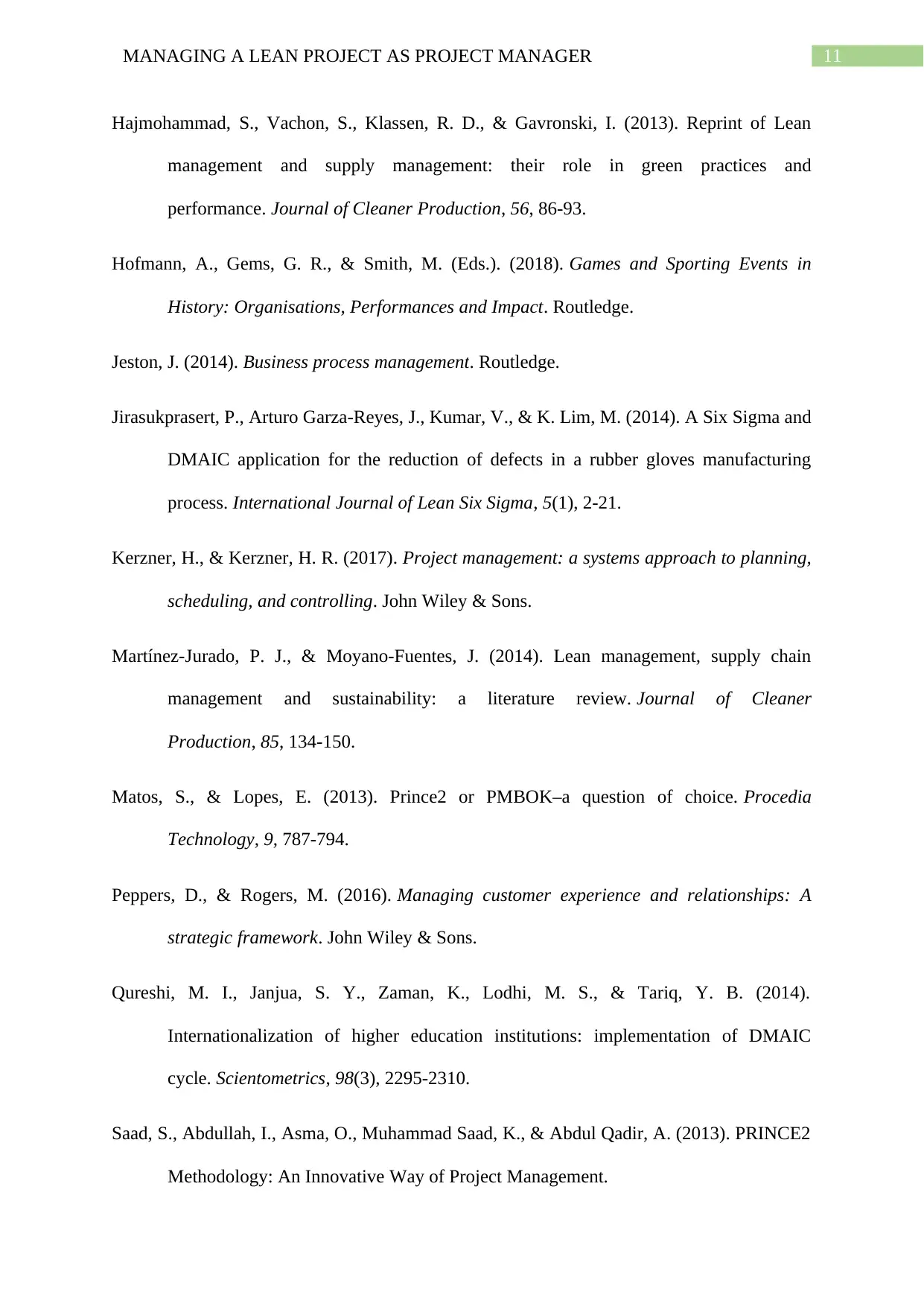
11MANAGING A LEAN PROJECT AS PROJECT MANAGER
Hajmohammad, S., Vachon, S., Klassen, R. D., & Gavronski, I. (2013). Reprint of Lean
management and supply management: their role in green practices and
performance. Journal of Cleaner Production, 56, 86-93.
Hofmann, A., Gems, G. R., & Smith, M. (Eds.). (2018). Games and Sporting Events in
History: Organisations, Performances and Impact. Routledge.
Jeston, J. (2014). Business process management. Routledge.
Jirasukprasert, P., Arturo Garza-Reyes, J., Kumar, V., & K. Lim, M. (2014). A Six Sigma and
DMAIC application for the reduction of defects in a rubber gloves manufacturing
process. International Journal of Lean Six Sigma, 5(1), 2-21.
Kerzner, H., & Kerzner, H. R. (2017). Project management: a systems approach to planning,
scheduling, and controlling. John Wiley & Sons.
Martínez-Jurado, P. J., & Moyano-Fuentes, J. (2014). Lean management, supply chain
management and sustainability: a literature review. Journal of Cleaner
Production, 85, 134-150.
Matos, S., & Lopes, E. (2013). Prince2 or PMBOK–a question of choice. Procedia
Technology, 9, 787-794.
Peppers, D., & Rogers, M. (2016). Managing customer experience and relationships: A
strategic framework. John Wiley & Sons.
Qureshi, M. I., Janjua, S. Y., Zaman, K., Lodhi, M. S., & Tariq, Y. B. (2014).
Internationalization of higher education institutions: implementation of DMAIC
cycle. Scientometrics, 98(3), 2295-2310.
Saad, S., Abdullah, I., Asma, O., Muhammad Saad, K., & Abdul Qadir, A. (2013). PRINCE2
Methodology: An Innovative Way of Project Management.
Hajmohammad, S., Vachon, S., Klassen, R. D., & Gavronski, I. (2013). Reprint of Lean
management and supply management: their role in green practices and
performance. Journal of Cleaner Production, 56, 86-93.
Hofmann, A., Gems, G. R., & Smith, M. (Eds.). (2018). Games and Sporting Events in
History: Organisations, Performances and Impact. Routledge.
Jeston, J. (2014). Business process management. Routledge.
Jirasukprasert, P., Arturo Garza-Reyes, J., Kumar, V., & K. Lim, M. (2014). A Six Sigma and
DMAIC application for the reduction of defects in a rubber gloves manufacturing
process. International Journal of Lean Six Sigma, 5(1), 2-21.
Kerzner, H., & Kerzner, H. R. (2017). Project management: a systems approach to planning,
scheduling, and controlling. John Wiley & Sons.
Martínez-Jurado, P. J., & Moyano-Fuentes, J. (2014). Lean management, supply chain
management and sustainability: a literature review. Journal of Cleaner
Production, 85, 134-150.
Matos, S., & Lopes, E. (2013). Prince2 or PMBOK–a question of choice. Procedia
Technology, 9, 787-794.
Peppers, D., & Rogers, M. (2016). Managing customer experience and relationships: A
strategic framework. John Wiley & Sons.
Qureshi, M. I., Janjua, S. Y., Zaman, K., Lodhi, M. S., & Tariq, Y. B. (2014).
Internationalization of higher education institutions: implementation of DMAIC
cycle. Scientometrics, 98(3), 2295-2310.
Saad, S., Abdullah, I., Asma, O., Muhammad Saad, K., & Abdul Qadir, A. (2013). PRINCE2
Methodology: An Innovative Way of Project Management.
⊘ This is a preview!⊘
Do you want full access?
Subscribe today to unlock all pages.

Trusted by 1+ million students worldwide
1 out of 13
Related Documents
Your All-in-One AI-Powered Toolkit for Academic Success.
+13062052269
info@desklib.com
Available 24*7 on WhatsApp / Email
![[object Object]](/_next/static/media/star-bottom.7253800d.svg)
Unlock your academic potential
Copyright © 2020–2025 A2Z Services. All Rights Reserved. Developed and managed by ZUCOL.


